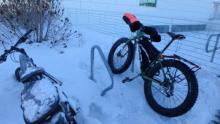Update
Team Announcement: Due to unexpected circumstances, Ivy McDaniel will not be going to the field this season with the research team.
What Are They Doing?
 A thermokarst at Wolverine Lake, near Toolik Lake, Alaska. Photo by Lauren Watel.
A thermokarst at Wolverine Lake, near Toolik Lake, Alaska. Photo by Lauren Watel.
Team Announcement: Due to unexpected circumstances, Ivy McDaniel will not be going to the field this season with the research team.
Tremendous stores of organic carbon frozen in permafrost soils have the potential to greatly increase the amount of carbon in the atmosphere. Permafrost soils may thaw sporadically and melting ground ice can cause land-surface sinking called "thermokarst failures". These failures change the rate and amount of carbon released with the unanticipated outcome being that soil carbon can be mixed-up from a depth and exposed to sunlight as the land surface is altered. Sunlight can photo-degrade or break-down organic carbon and alter the carbon's ability to support bacterial respiration to produce carbon dioxide. Whether sunlight and UV exposure will enhance or retard the conversion of newly exposed carbon to carbon dioxide is currently unknown—this study is providing the first evidence that this alteration will be amplified by photochemical processes and their effects on microbes.
The research team is trying to understand exactly how sunlight and bacteria degrade dissolved organic matter by determining how fast these processes convert newly released dissolved organic matter to carbon dioxide, compared to dissolved organic matter already in surface waters. The team is accomplishing their research objectives with a series of laboratory experiments to determine rates of photodegradation and microbial processing of dissolved organic matter from different sources, and a series of landscape comparisons and sampling transects to characterize dissolved organic matter degradation in small basins and large rivers extending from the headwaters to the Arctic Ocean. Ultimately, this research will attempt to answer questions such as whether carbon export from tundra to oceans will rise or fall and how reactive the exported carbon will be. The team hopes to be able to measure the ultimate impact of impending disturbances, including climate change, on the net carbon balance of the Arctic and its interaction with the global carbon cycle.
Where Are They?
 Toolik Lake in evening light. Photo by Regina Brinker.
Toolik Lake in evening light. Photo by Regina Brinker.
The research team was based out of Toolik Field Station, an 8-10 hour drive north from Fairbanks, Alaska. Toolik Field Station is operated by the Institute of Arctic Biology at the University of Alaska Fairbanks and has hosted hundreds of researchers and students every year since 1975. From the field station, the team traveled to their sites by foot, truck, boat and occasionally by helicopter.
Latest Journals

Dr. Rose Cory works in the Arctic where climate warming is thawing frozen soil which may release tremendous stores of dissolved organic carbon to the Earth's surface. After having been trapped for millennia in the frozen soils this new carbon then becomes part of the modern carbon cycle. Dr. Cory finds that exposure to sunlight accelerates the return of this dissolved organic carbon to the atmosphere as carbon dioxide, which may further increase the rate of global warming. Because climate change is influencing our planet's evolution, understanding the fate of newly released carbon will help predict our future as a planet and society. Read more about Dr. Cory and her research here




